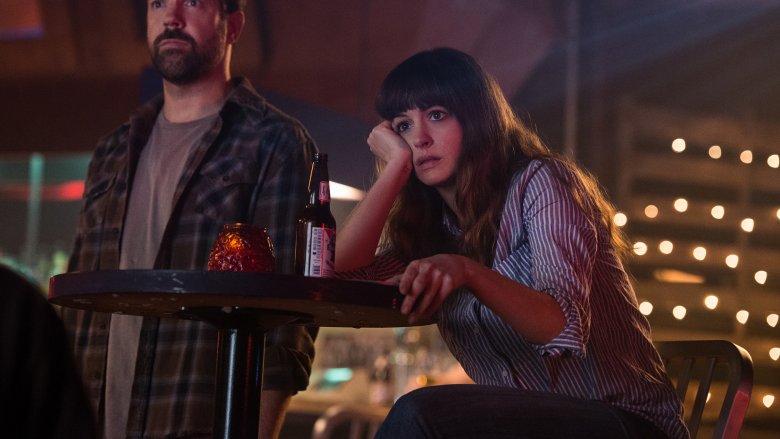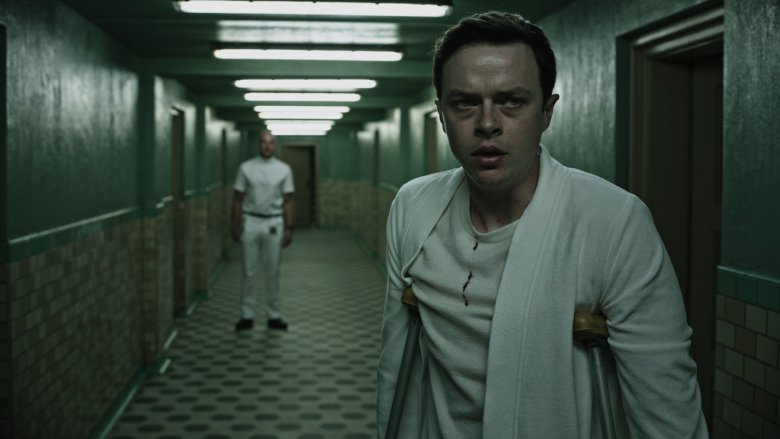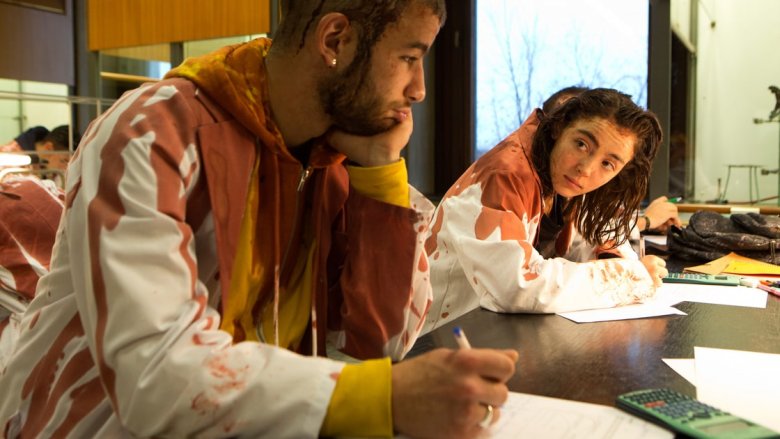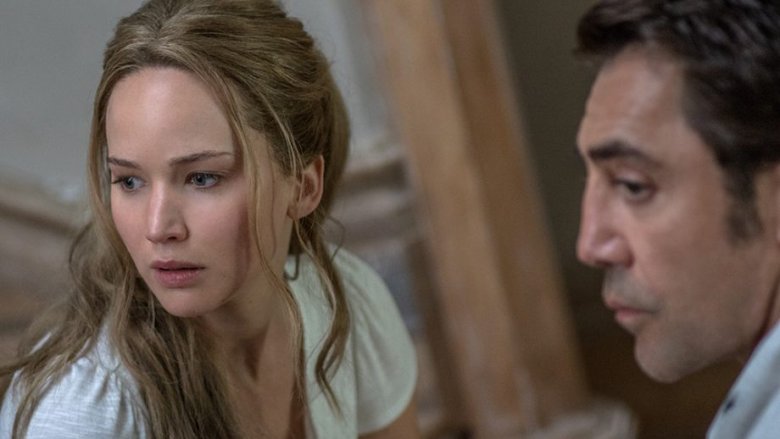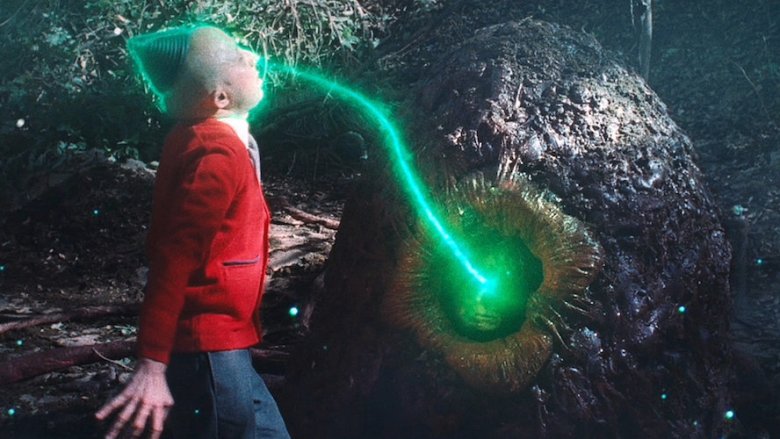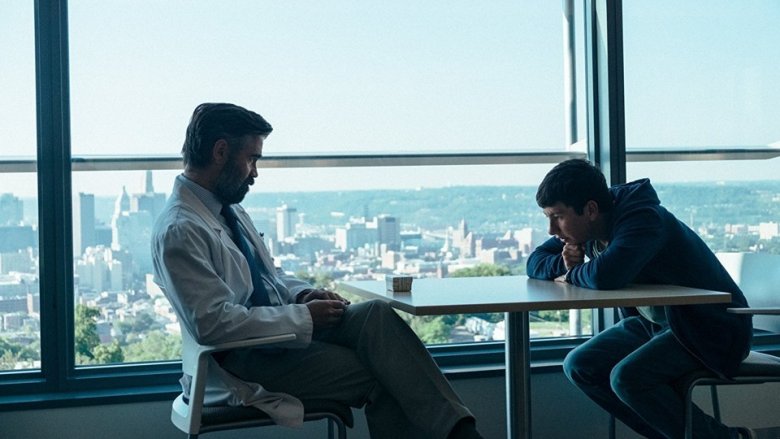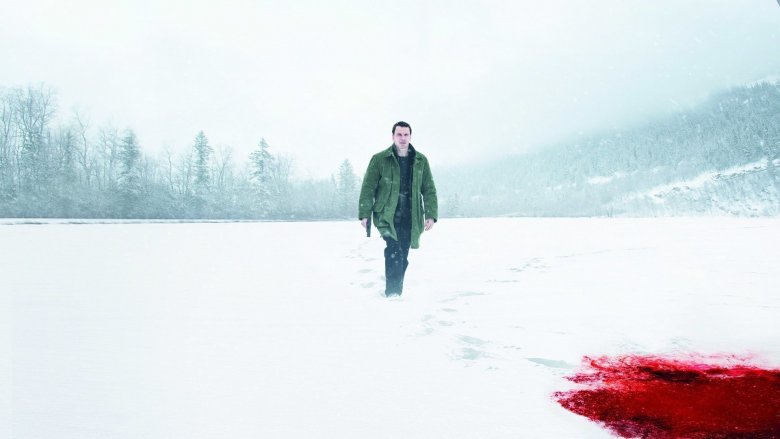The Most Confusing Movies Of 2017
Movies inspire us, scare us, make us laugh, make us cry. Sometimes, however, they just leave us confused. You know the feeling. You're at the cinema, watching the latest movie. When the credits roll, you sit in silence, stare at the screen, scratch your head, and ask yourself, "What the hell just happened?"
Below are 2017's most confusing movies, from vomit-inducing body horror to storylines with more twists than the Swiss Alps.
Warning: This article contains some spoilers and plot details for each movie.
The Bad Batch
Set in the near future, The Bad Batch refers to the exiled criminals sentenced to live in a lawless, cannibal-ridden wilderness. The neon-drenched backdrop of Comfort — a seeming safe society where humans eat rabbits and not each other — doesn't need a backstory. The relationship between Arlen (Suki Waterhouse) and Miami Man (Jason Momoa), however, appears to counteract each character's motive.
In a grim introduction, Arlen is tattooed with a prison number and dumped in the desert. She is abducted and drugged; her limbs are soon amputated and devoured by a group of cannibals. Though she later escapes, she understandably resents those responsible. Months later, she stumbles across a mother and daughter scavenging the landscape. Realizing they're cannibals, she kills the mother and abducts the daughter.
That's Miami Man's partner and daughter. When searching for them, he discovers his partner's corpse, with little indication of grief. He then heads to Comfort in search of the missing child. Fortuitously, he meets Arlen. Unaware she is responsible for her disappearance, he asks her to help with the search. The pair then strike a peculiar friendship. Miami Man is earlier shown to be a ruthless leader of a cannibal clan. He thinks nothing of breaking a woman's neck with his bare hands, despite her begging for mercy. Aware of his background, Arlen doesn't hide the fact she hates his kind.
This setup suggests serious consequences once it's Arlen's abduction of the daughter is revealed, but this reveal never comes. There's little explanation why such an important plot device is left alone. After the daughter goes missing in Comfort, Arlen is determined to find her and reunite her with Miami Man. When finally reunited thanks to Arlen's help, the daughter, for some odd reason, doesn't tell Miami Man that it was Arlen who murdered her mother.
In the end, Arlen rejects the opportunity to join Comfort leader The Dream (Keanu Reeves) in a more-than-comfortable existence, asking Miami Man if she can join him on the outside — a questionable deviation from all earlier behavior.
Personal Shopper
Smashing glasses, ectoplasm, half-open doors, and things-that-go-bump-in-the-night. Personal Shopper has all the hallmarks of a traditional supernatural horror, but Olivier Assayas' thoughtful meditation on grief is anything but traditional, swapping jump scares for ambiguous, psychological trickery.
Maureen (Kristen Stewart) is a personal shopper by day, medium by night. After her twin brother Lewis dies of a genetic heart condition, Maureen sets down a paranormal path of discovery to actualize a deal the pair made — the first to die will contact the other from beyond the grave.
Assayas crafts a nuanced story that interweaves the narrative of Maureen's grief with the gruesome murder of her celebrity boss, Kyra (Nora von Waldstätten). This is where the lines between reality, paranormal, and imagination blur, particularly in the final third of the film. Whether Maureen really is communicating with her late brother or being manipulated due to her fragile mental state, is far from clear.
Despite lots of room for interpretation, including wild theories such as a Sixth Sense-style twist where Maureen was dead all along, director Assayas stripped away all mystery from the conclusion by explaining his vision during a press conference. He explained "there were no ghosts, [Maureen's] brother was not really speaking to her. It was her own path to find herself ... survive the loss of her brother and find her [own] identity."
That's settled then.
Colossal
Colossal is a monster movie with a colossal twist. After repeated drunken misbehaviour, Gloria (Anne Hathaway) is thrown out of her boyfriend's apartment in New York. Determined to get her life on track, she returns to her hometown in New England. Not long after arriving, she bumps into an old school friend, Oscar (Jason Sudeikis).
Gloria's drinking problems persist as she strikes a friendship with Oscar and his two buddies — Joel (Austin Stowell) and Garth (Tim Blake Nelson). Director Nacho Vigalondo throws up surprise after surprise, starting with the casual introduction of a monster attack in Seoul, South Korea. For those heading into the film blind, this seems at odds with the film's palette, and may catch some off guard. Of course, this attack has a direct link with Gloria's story — she makes the chilling realisation that she is inexplicably linked to the monster.
When new friend Oscar discovers he also has the same monster-replicating superpower, Colossal follows another tonal shift. Oscar shows his sinister side, callously manipulating Gloria by threatening to morph himself into the monster — thus killing thousands in the process — if she doesn't comply with myriad demands. Oscar's chilling behavior turns the monster storyline into a conduit for emotional and physical abuse. This leaves Gloria the challenge of overcoming her demons, both real and imagined.
Vigalondo uses monster-movie tropes to provide a shrewd commentary on very real issues. Though executed well, the film's core is at odds with a lighthearted marketing campaign, which could surely mislead some viewers.
Song to Song
Masterpiece or pretentious self-indulgence? Terrence Malick's style frequently divides opinion, and Song to Song is no different. Malick depicts a love-hexagon of the privileged in a way only he can, weaving a complex web of infidelity, betrayal, broken hearts, and sentimentality in fluid edits and unconventional framing.
The narrative itself is straightforward. Set in the cutthroat music industry, hopeful musician Faye (Rooney Mara) begins an ill-conceived relationship with powerful music producer Cook (Michael Fassbender) to help progress her career. However, she falls in love with B.V. (Ryan Gosling), another musician working closely with Cook and begins a relationship with him as well. After forming a three-way friendship, Faye, B.V., and Cook navigate the landscape of music festivals and cocktail parties, as Faye's infidelity continues.
What makes Song to Song both brilliant and baffling is its replication of memory and consciousness, reminiscent of Malick's Tree of Life. Imagine each of the lead characters alone, reflecting on the past. The love story unfolds as if Malick cherry-picked these reflections directly from the characters' brains, gathering them in a collective stream of consciousness before piecing them together in a semi-linear structure.
Although admirable, this structure isn't easy to follow. Like memory, the flow of the story abruptly diverts, changing direction on the whim of a voice over, a glance, or gentle touch. No wonder Malick originally had an eight-hour cut.
A Cure for Wellness
Set in breathtaking backdrop of the Swiss Alps, no one can claim Gore Verbinski's aesthetically pleasing thriller lacks ambition. In fact, A Cure for Wellness suffers from being overly ambitious. Like its mountainous terrain, the story twists, turns, and ultimately disorientates.
Events initially appear straightforward. Up-and-coming executive Lockhart (Dane DeHaan) is tasked with retrieving his company's CEO, Roland Pembroke (Harry Groener), from a hiatus at a Swiss wellness center. To his frustration, the staff at the center won't allow him to talk to Pembroke. On his way out of the center, Lockhart is involved in a car crash. He awakens from the accident to find himself a patient at the same wellness center, his leg broken and covered in plaster. Shutter Island springs to mind as Lockhart and his crutches squeak their way through a hallucinogenic journey filled with disappearing doorways, mysterious underground lairs, and bizarre fables.
The center is hiding a terrible secret, and Lockhart is on a mission to find out what. The slow-reveal of the truth is frustrating and borderline nonsensical. In a nutshell, the center's head honcho, Dr. Heinreich Volmer (Jason Isaacs), is in fact a 200-year-old Swiss baron (who was said to have died a horrible death years earlier), who has slowed his aging process by extracting a vitamin-like substance from the center's patients.
Lockhart befriends another patient, Hannah (Mia Goth), who we discover is Volmer's daughter. In a bizarre subplot, Volmer, it turns out, has been waiting for her to come of age, so he can rape her and create some kind of übermensch offspring. The trouble is, by the time Volmer's plan is revealed, the story has already lost steam.
Raw
Julia Ducournau brings new meaning to the slogan "finger lickin' good" with Raw, the second cannibal-themed movie on this list. Unlike The Bad Batch, Raw gets under the skin because of its eerie authenticity, replacing a dystopian wasteland with the familiar backdrop of university. This realistic depiction makes the French-Belgian horror too strong for some; at the 2016 Toronto Film Festival, there were reports of audience members fainting.
Such a visceral reaction is understandable. Raw begins like an innocuous coming-of-age tale: Justine (Garance Marillier) leaves home to join veterinary school, where her sister is also studying. During an unforgiving hazing process, she breaks her strict vegetarianism when she is forced by her sister to consume a raw rabbit kidney. This is where things gets really weird. Really weird.
Having had a taste, Justine embarks on a cannibalistic quest of munching flesh that quickly grows out of hand. Select scenes include Justine nibbling her sister's recently amputated finger with all the vigor of someone eating KFC on a hangover, a slightly-too-long shot of her gagging and regurgitating a yeti-sized hairball, and worse. Much worse.
It's important to note, however, Ducournau doesn't broach such a taboo subject gratuitously. Raw is hard to comprehend, but it's hard because it emotes a primal instinct in the viewer, reflecting the darkest parts of ourselves. Consequently, the conclusion will leave chills down your spine — and a bite mark on the memory.
mother!
Director Darren Aronofsky said the script for mother! poured out of him like a "fever dream." Even from the mind that created the likes of Requiem For a Dream and Black Swan, mother! dives to surprisingly dark depths of nightmarish vulgarity, ultra-violence and barbaric bewilderment.
It begins with Mother (Jennifer Lawrence) and Him (Javier Bardem), who are living a life of quiet solitude. Man (Ed Harris) makes an unsolicited appearance at their door, asking to stay, followed by his wife, Woman (Michelle Pfeiffer). Much like the flames that engulf the house at the beginning and end, events rapidly blaze out of control as more and more people arrive. Its entirety takes place within the claustrophobic and confined setting, which eventually descends into a war zone, and an all-out assault on the senses.
On top of graphic violence (a scene involving Mother's newborn is as testing as it can get in cinema) mother!'s most unnerving moments are delivered with everyday, social non-conforming malice, where strangers show complete disregard for Mother's wishes. Trying to decipher the surreality at face value will leave many guessing.
However, mother!'s metaphysical explanation helps the story make sense. Aronofsky confirmed that his film is a biblical allegory, representing the story of creation, with the house representing the Earth, and the damage done to it, the impact of climate change.
Kuso
Most of the films on this list are confusing because they require post-viewing reflection. Kuso requires post-viewing repression. Created by music producer Flying Lotus, with the help of Salad Fingers brainchild David Firth, Kuso is absurdity for absurdity's sake. Its graphic horror sparked walkouts at Sundance Film Festival, and in a self-aware nod at the film's content, audiences were provided with sick bags.
Split into four different segments, the spectacle places an all-too-close spotlight on the boil-covered survivors of a devastating Earthquake in L.A. Without spoiling the "fun," scenes include boils doing unspeakable things, a man's privates being stabbed in a way that make the film Antichrist look tame, and a doctor who encourages patients to sing to his anus to wake a giant cockroach from his anal cavity. Yes, you read that correctly ...
Is it completely without meaning? There's an argument that no artform is meaningless, and there's certainly a level of ingenuity that makes Kuso an unforgettable and unique exploitation film. It has something to say about sexual desire and survival, but its execution makes Kuso one of the most confusing films of the year — and one the grossest of all time.
Killing of a Sacred Deer
Yorgos Lanthimos is no stranger to eccentricity. He directed 2016's The Lobster, a story about a hotel where its single residents have 45 days to find a new romantic partner or else they turn into animals. Initially, Killing of a Sacred Deer appears less bizarre. Scratch a scalpel under the surface though, and Lanthimos outshines his earlier effort.
The story focuses on talented surgeon Steven (Colin Farrell) who befriends a boy, Martin (Barry Keoghan). Sprinkled with the director's trademark deadpan dialogue, there are numerous quirks and dark humor moments that require close inspection. There's the weird obsession with body hair, a bearded and straight-faced Colin Farrell shouting, "I don't suppose you've got any pubes lying around?!" and Nicole Kidman — as Steven's wife Anna — pretending to be an anesthetized patient for sexual kicks. But that's nothing compared to story's core.
The boy Martin is out for revenge, believing Farrell's Steven responsible for the death of his father. Martin tells Steven he has placed a curse on his family in an act of vengeance. To undo the curse, Steven has to kill a member of his own family, or they will all die a slow and painful death. Much to Steven's exasperation, Martin's curse begins to manifest as his children lose the ability to walk.
How Martin enacts the curse is anyone's guess; he's seemingly able to make symptoms come and go. Those looking for answers won't get anything concrete either, and it's compounded by an ambiguous ending that gives little away.
The Snowman
Ah, The Snowman. Expectations were high: Director Tomas Alfredson was the mastermind behind one of the finest horror films of a generation, Let the Right One In; Michael Fassbender took the lead; the film's editor, Thelma Schoonmaker, is a three-time Oscar winner; Jo Nesbø's novel provided quality source material. With such talent on both sides of the camera, how did the film end up with a 7% score on Rotten Tomatoes?
The issue certainly wasn't Nesbø's source material. His novel of the same name is the seventh featuring alcoholic detective Harry Hole. Following the same premise as Nesbø's novel, the story follows Hole (Fassbender) as he searches for a depraved serial killer whose trademark is to leave a snowman at his victim's houses.
Unfortunately, issues with production melted any hopes of The Snowman being a hit. It's no surprise; Alfredson admitted to The Norwegian Broadcast Association that a tight production schedule had a damaging effect. He admitted, "We didn't get the whole story with us, and when we started cutting we discovered that a lot was missing." A short shoot time in Norway left Alfredson to compare the process to a "big jigsaw puzzle" with "a few pieces missing." Those pieces results in 10 to 15% of the script un-filmed.
Though Alfredson received extra funds for re-shoots, the damage was done. The result is a disjointed and confusing experience, with choppy editing, important storylines that are never concluded, and characters introduced and later disappearing with no rhyme or reason.


